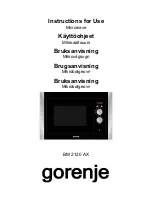
7
GENERAL SAFETY
ALWAYS use potholders
to prevent
burns when handling utensils that
are in contact with hot food. Enough
heat from the food can transfer
through utensils to cause skin burns.
Avoid steam burns
by directing
steam away from the face and
hands. Slowly lift the farthest edge
of a dish’s covering and carefully
open popcorn and oven cooking
bags away from the face.
Stay near the drawer microwave
while it’s in use and check cooking
progress frequently so that there is
no chance of overcooking food.
NEVER use the cavity for storing
cookbooks or other items.
Select, store and handle food care-
fully
to preserve its high quality and
minimize the spread of foodborne
bacteria.
Keep waveguide cover clean.
Food
residue can cause arcing and fires.
See page 28.
Keep aluminum foil used for shield-
ing
at least 1 inch (25) away from any
surface of the drawer microwave.
(See page 12 for details.)
ALWAYS have food in the
microwave oven when it is on
to
absorb the microwave energy.
The vent under the drawer
microwave must not be blocked.
During microwaving, steam may
come from the right side of the vent.
If the oven light fails,
consult a Wolf
authorized service center.
Stir liquids briskly
before and after
heating to avoid “eruption”.
Use deep bowl,
when cooking liquids
or cereals, to prevent boilovers.
Food should be shorter than the
drawer microwave.
Please refer to
the height of side walls of the drawer.
Don’t dry wood, gourds, herbs or
wet papers.
When using the drawer microwave
at power levels below 100%,
you
may hear the magnetron cycling on
and off. It is normal for the exterior
of the oven to be warm to the touch
when cooking or reheating.
Condensation is a normal part of
microwave cooking.
Room humidity
and the moisture in food will influ-
ence the amount of moisture that
condenses in the oven. Generally,
covered foods will not cause as
much condensation as uncovered
ones.
The drawer microwave is for food
preparation only.
It should not be
used to dry clothes or newspapers.
Your drawer microwave is rated
950 watts by using the IEC Test
Procedure.
In using recipes or
package directions, check food a
minute or two before the minimum
time and add time accordingly.
When opening or closing the drawer
microwave quickly, food in the
drawer microwave may be spilled. To
clean, please refer to the Cleaning
and Care section on page 28.








































